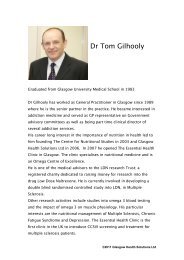ISNVD Abstract Book
ISNVD Abstract Book
ISNVD Abstract Book
Create successful ePaper yourself
Turn your PDF publications into a flip-book with our unique Google optimized e-Paper software.
Purpose<br />
Kenneth Mandato, MD; Jedidiah G Almond, MD; Meridith Englander, MD<br />
Shirish Parikh, MD; Gary P Siskin, MD<br />
Radiology at Albany Medical College Albany, NY<br />
To evaluate the ability of ultrasound (US) to diagnose chronic<br />
cerebrospinal venous insufficiency (CCSVI) in patients with<br />
multiple sclerosis.<br />
Materials and Methods<br />
A retrospective study of all MS patients treated for CCSVI<br />
during an 8-month period was performed. The study<br />
population consisted of all patients undergoing US of the<br />
internal jugular veins (IJV) within 24 hours of venography.<br />
Patients who received a diagnostic ultrasound at another<br />
institution before undergoing treatment were not included<br />
in this analysis. US was performed utilizing the protocol<br />
described by Zamboni, et al. A positive US met 2/5 criteria<br />
for CCSVI. The US results were also evaluated based on the<br />
findings on each side (right or left). A positive unilateral US<br />
met 2/4 criteria (without the transcranial evaluation of the<br />
deep cerebral veins). A positive venogram was defined as<br />
one identifying a ≥50% stenosis in at least one vein,<br />
including the azygos vein. The US and venography findings<br />
were then compared to determine if US is an effective tool<br />
for diagnosing CCSVI.<br />
Figure 1A: Realtime doppler sonography reveals normal<br />
<br />
<br />
<br />
<br />
<br />
<br />
<br />
<br />
<br />
venography<br />
Results<br />
416 patients were treated during the study period; the study<br />
population consisted of 310 patients (mean age 49 years;<br />
30% male and 70% female). 224/310 patients (72%) had a<br />
positive US, and 155 (69%) of these patients had a positive<br />
CV; 86/310 patients (28%) had a negative US, and 66 (77%)<br />
of these patients had a positive venogram (p=0.240) [Figures<br />
1A, 1B]. An ROC curve was generated to further evaluate<br />
ultrasound as a diagnostic test and the AUC=0.463. 300/310<br />
(97%) patients underwent PTA of at least one vessel (215/224<br />
with a positive US and 85/86 with a negative US) because<br />
venography showed either a ≥50% stenosis or a flow<br />
abnormality in association with a




